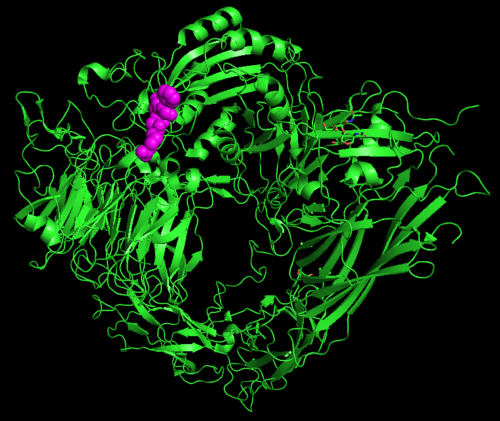
Integrin αvβ3 and RGD Binding
The Background, Advantages of, and Considerations for Radiolabeled Peptides
The use of radiolabeled peptides is a well-established tool in researching and treating many diseases and conditions. Selective receptor-targeting peptides are utilized as agents due to their rapid circulatory and tissue clearance and the high affinity and specificity to their targets. Peptides also have a relatively small size and low molecular weight compared to proteins and antibodies. There have been innovations and improvements in the design of peptides that incorporate chemical modifications with “impressive diagnostic accuracy and sensitivity.”1 Coupling these peptides with radiolabeling for peptide receptor radionuclide imaging (PRRI) and therapy (PRRT) has yielded remarkable results. In fact, a historical summary of radiolabeled peptides asserts, “The emergence of radiolabeled peptides for use with PET/CT such as 68Ga, 18F, and 64Cu, and the use of new receptor binding ligands…, have revolutionized PRRI and improved its diagnostic power beyond expectation.”2
“Criteria for a successful peptide tracer,” to be utilized for PRRI, “are a high target specificity, a high binding affinity, long metabolic stability, and a high target-to-background ratio.”3
Oncology and Radiolabeled Peptides
Oncology has benefited from the “tumor-philic” properties of Arg-Gly-Asp (RGD) peptides “because of their high affinity and selectivity for integrin αvβ3 – one of the most extensively examined targets of angiogenesis. Since the level of integrin αvβ3 expression has been established as a surrogate marker of angiogenic activity, imaging αvβ3 expression can potentially be used as an early indicator of the effectiveness of antiangiogenic therapy at the molecular level.”4 In addition to integrin αvβ3 expression, “tumor angiogenesis…has been well recognized as an essential hallmark for tumor growth, invasion, and metastasis.”4 All this has made RGD-containing peptides “promising molecular agents for imaging angiogenesis.”5
Beyond Oncology
Since integrins are “involved in adhesion between cells and the extracellular matrix” and, as such, are associated with normal and pathological states, this family of receptors is useful for targeting a range of diseases.6 Current applications include “cardiovascular imaging, atherosclerosis imaging, remodeling after myocardial infarct or stroke, imaging of myocardial ischemia, identification of abdominal aortic aneurysm, imaging of chronic inflammation, pulmonary inflammation, assistance with bone marrow evaluations, and tissue engineering.”6
A Brief History of RGD Peptides and Radiolabeling
Although radiopharmaceutical therapies, which can concurrently detect and treat tumors (i.e., theranostics, a portmanteau of therapeutics and diagnostics), have been around for eighty years, it was not until the combination of these payloads was combined with peptides that the potential for better targeting became a reality. The use of the RGD peptide sequence to attach to cells was first reported by M.D. Pierschbacher and E. Ruoslahti in Nature, nearly forty years ago in 1984, as a feature of fibronectin.5,7 Next, targeting tumors with radioactive peptides began, initiated by OctreoScan’s breakthrough in the early 1990s, wherein somatostatin receptor subtype 2 (SST-2) positive tumors were identified.8,9 After that, the first monomeric integrin-specific PET tracer used in patients was F-Galacto-RGD, a glycosylated RGD-peptide.5,10 Since then, the tripeptide R-G-D sequence has generally been utilized as a tracer, carrying the isotope to integrins that are expressed on both tumor cells and activated endothelial cells of tumor neo-vasculature. In the ensuing years, advancements have continued apace, and going forward, the intersection of PRRI/PRRT from radiolabeled peptides combined with AI, precision, and personalized medicine assures transformative innovations.
Obstacles and Numerous Options for Radiolabeled Peptide Production
Because of their established safety, development, and design history, and “the fact that there are many RGD-based tracers with known pharmacokinetics, it can be useful to use them in the imaging of diseases that currently have no accurate method of diagnosis available.”6 However, there are barriers to synthesizing radiolabeled peptides: it can be a time-consuming, complex, multi-step process. It is also highly variable based on the peptide. Other drawbacks include the intricacies of radiolabeling and the lack of automation for some of these protocols.
Fortuitously, RGDs radiopeptides are not the only ones exhibiting exciting potential for diagnostic imaging and targeted radionuclide therapies. An extensive review article from Paweł Kręcis et al. that appeared in Bioconjugate Chemistry is recommended, as it presents some developments and perspectives in both aforementioned areas regarding the research on somatostatin, bombesin, vasoactive intestinal peptide, gastrin, neurotensin, and exendin peptide analogs, among others.11 It includes the application of radiolabeled peptides and antibodies and an analysis of clinical trials reported in 2008-2018.
Finally, just a few of the current companies doing interesting things in radiopharmaceuticals include Aktis Oncology, Mariana Oncology, Point Biopharma, and Rayze Bio. AMPAC Fine Chemical and AMPAC Analytical, both SK pharmteco companies, have been at the vanguard of small molecule and analytical developments utilizing innovative technologies and techniques directed by teams with decades of experience. If you have a radiolabeled peptide targeted for development, our teams can design, validate, optimize, and analyze your project, ranging from research to commercial quantities. Contact us today for more information.
References
- https://www.ncbi.nlm.nih.gov/pmc/articles/PMC5235994/
- https://link.springer.com/article/10.1007/s00259-012-2064-5
- https://link.springer.com/article/10.1007/s00259-011-2038-z
- https://www.ncbi.nlm.nih.gov/pmc/articles/PMC4679356/
- https://www.ncbi.nlm.nih.gov/pmc/articles/PMC8924613/
- https://link.springer.com/article/10.1007/s00259-020-04975-9
- https://pubmed.ncbi.nlm.nih.gov/6325925/
- https://www.ncbi.nlm.nih.gov/pmc/articles/PMC6789871/
- https://www.cancer.gov/news-events/cancer-currents-blog/2018/lutathera-fda-gastrointestinal-nets
- https://pubs.acs.org/doi/10.1021/ja9603721
- https://pubs.acs.org/doi/full/10.1021/acs.bioconjchem.0c00617
Related Articles and Resources
- 68Ga-Labeled Radiopharmaceuticals for Positron Emission Tomography https://www.ncbi.nlm.nih.gov/pmc/articles/PMC4042918/
- Positron Emission Tomography (PET) Imaging with 18F-Based Radiotracers
https://www.ncbi.nlm.nih.gov/pmc/articles/PMC3478111/ - 64Cu-based Radiopharmaceuticals in Molecular Imaging
https://www.ncbi.nlm.nih.gov/pmc/articles/PMC6378420/ - Advances in Radionuclides and Radiolabeled Peptides for Cancer Therapeutics
https://www.mdpi.com/1999-4923/15/3/971

